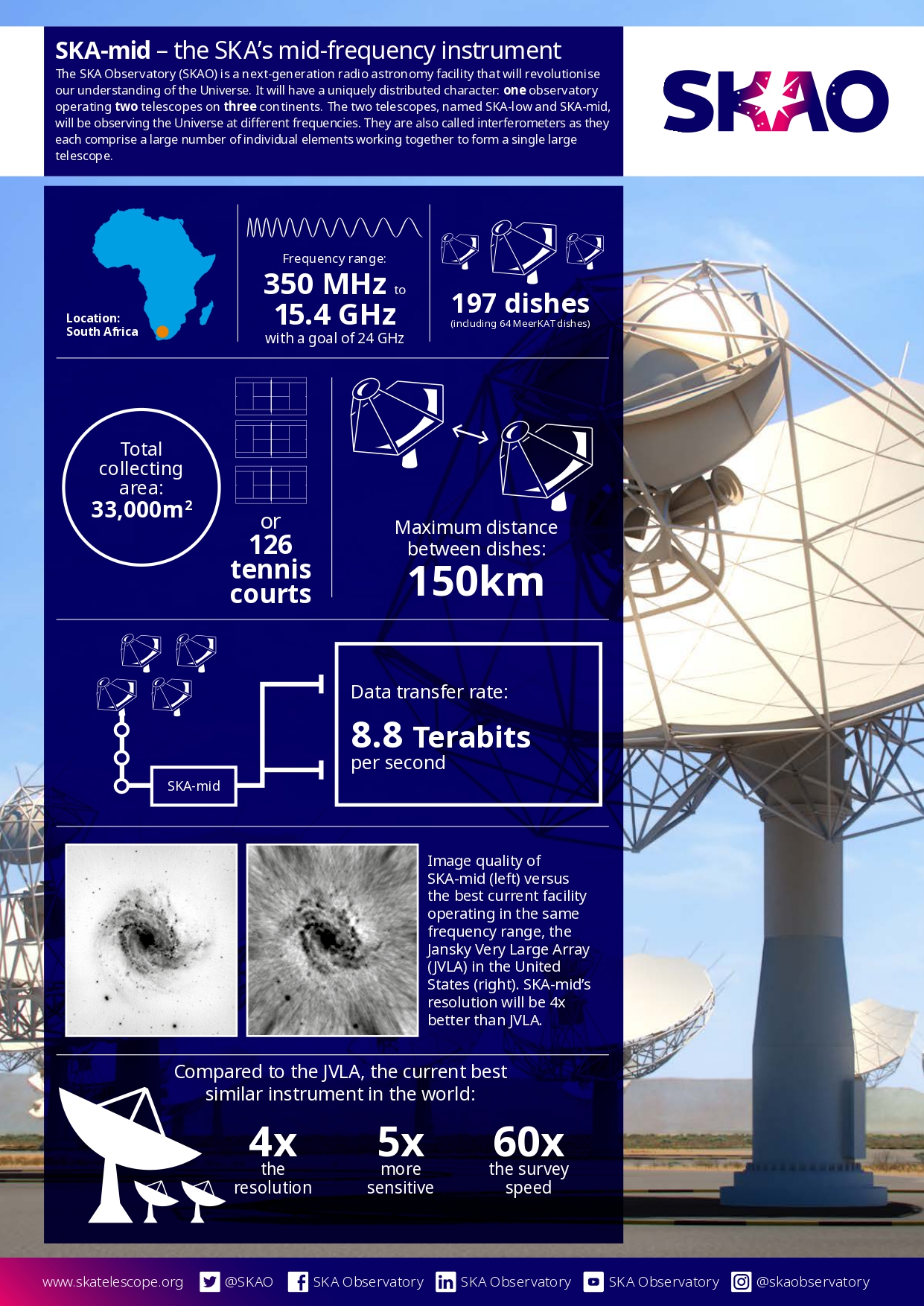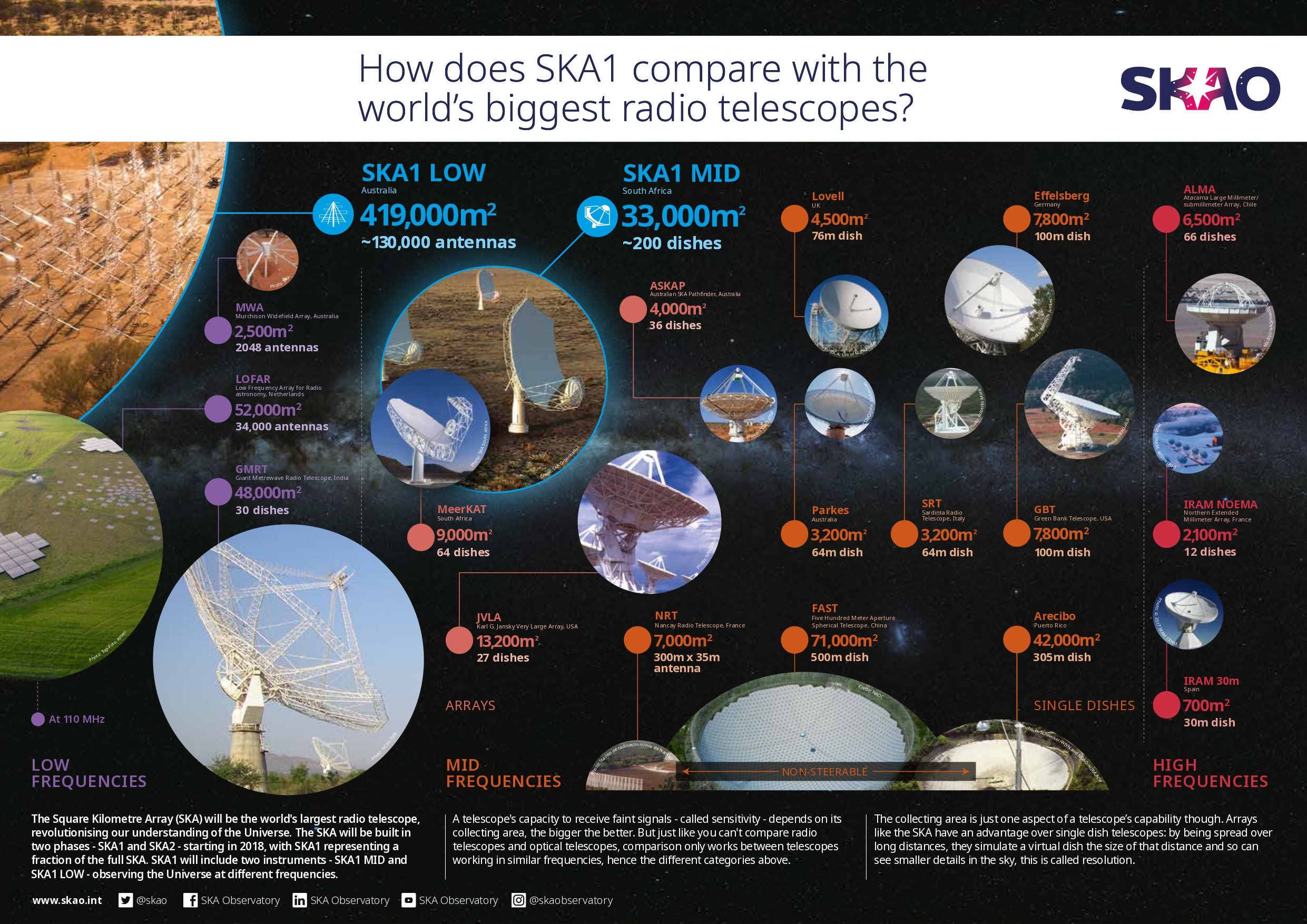SKA Observatory (SKAO): A guide to the soon-to-be largest radio telescopes in the world
The world's largest radio telescopes are being built in South Africa and Australia.

The Square Kilometre Array Observatory (SKAO) will deliver the next generation of radio telescopes — vast arrays of radio dishes and antennas spanning two continents.
Once constructed, the SKA telescopes will be, by far, the most powerful such instrument in the world according to the Australian Government's Department of Industry, Science and Resources. Scientific operations are expected to begin in 2028–29.
The name, 'Square Kilometre Array' comes from the original plan for all its antennas and dishes to have a combined effective area of one square kilometer (0.34 square miles). The plan had been scaled back due to cost with the hope to achieve it in the second phase.
Related: The 10 biggest telescopes on Earth
How will the SKA Observatory work?
The 197 dishes in South Africa are collectively referred to as SKA-Mid and will observe at radio frequencies between 350 MHz and 15.4 GHz. They have a combined effective collecting area of 355,000 square ft (33,000 square meters). In Australia, the 131,072 low-frequency antennas are known as SKA-Low, and have a combined collecting area of 4,510,000 square feet (419,000 square m), with a maximum baseline of 46 miles (74 km).
The collecting area is a crucial component that makes the SKAO so powerful. While the baseline of the array determines the resolving power, the collecting area determines the array's sensitivity, so that it can detect fainter objects.
The antennas of SKA-Low literally look like metallic trees, with horizontal branches called dipoles, shorter at the top and wider at the bottom, a bit like a stubby pine cone. The longer the dipole, the longer the radio wavelength it can detect.
Breaking space news, the latest updates on rocket launches, skywatching events and more!
Both SKA-Mid and SKA-Low are 'interferometers', which means that they use a technique called 'aperture synthesis', connecting multiple telescopes in different locations to act as one.
Thousands of miles of optical fiber link the individual dishes and antennas, and sophisticated software is able to take the data that each telescope collects and combine it precisely, using perfect synchronization for the different times it takes for the signals from the various dishes and antennas to reach the central processing system. The result is that each array acts as one giant telescope rather than myriad smaller telescopes.
Where is the SKAO being built?
The SKA telescopes will consist of 197 large, parabolic radio dishes, and 131,072 low-frequency antennas. The large dishes will be located in a region of South Africa called the Karoo, and the largest distance between any two dishes is 93 miles (150 km). Astronomers call this distance between one side of the array to the other the 'baseline' and, in the future, the plan is to extend the telescope's baseline by building more remote dishes in nearby countries, including Botswana, Ghana, Kenya, Madagascar, Mauritius, Mozambique, Namibia and Zambia. Increasing the baseline will increase the SKA-Mid telescope's resolving power, so that it can resolve finer detail in radio-emitting objects.
Meanwhile, the 131,072 small, low-frequency antennas form a steel forest of two-meter-tall (6.6 feet) wire structures, divided into 512 stations of 256 antennas each, located at Inyarrimanha Ilgari Bundara, the CSIRO Murchison Radio-astronomy Observatory in Western Australia.
Why build the SKA telescopes in the Southern Hemisphere?
Sites in the Southern Hemisphere were chosen to be the locations of the SKA Observatory because they have a clear view of the entirety of the Milky Way, as well as views out into intergalactic space. In contrast, from more northerly countries such as the U.K., the core of our galaxy barely scrapes above the horizon during the summer months. However, the U.K. is not without its contribution to the SKA Observatory as its headquarters is at the Jodrell Bank Observatory in Cheshire, England.
SKAO FAQs answered by an expert
We asked Philippa Hartley, an Square Kilometre Array Observatory (SKAO) scientist a few frequently asked questions about the project.

Dr Philippa Hartley is an astrophysicist and project scientist for the Square Kilometre Array Observatory (SKAO).
What do you hope to achieve with the SKA telescopes?
The SKA telescopes will be used by people all over the world to study a whole range of phenomena, from the puzzles of dark matter and dark energy to the signatures of life beyond Earth. Perhaps the most exciting thing of all, in the great tradition of radio astronomy, is the potential for completely new discoveries: the exploration of the unknown.
Why is radio astronomy important to our understanding of the universe?
Through radio astronomy, we see the universe in a completely different way, revealing extreme events in space that would otherwise remain invisible: spinning pulsars tearing up space and time; jets of plasma spewed away from supermassive black holes at close to the speed of light.
Radio astronomy can study these objects to test Einstein’s theory of gravity and to see how galaxies have evolved over the history of the universe. Radio waves also track magnetism across cosmic scales and can even trace the hydrogen gas that made up the first stars: through radio astronomy, we have a time machine that we can use to see the universe light up during the cosmic dawn.
How much more powerful will the SKA telescopes be compared to current ones?
Their huge collecting area will allow the SKA telescopes to produce images with 10-100 times the fidelity of current instruments, detecting objects far fainter and further away than can be seen by existing telescopes.
Why is one telescope in South Africa and the other in Australia? What will the two locations do differently, and will they work together?
The SKAO wanted to capitalise on existing investments in both countries and strengthen the global nature of the project. South Africa will host a mid-frequency instrument, scanning the sky for frequencies between 350 MHz and 15.4 GHz, while the SKA-Low telescope in Australia is designed for the 50-350 MHz range. The instruments are intended to complement each other.
What will the SKA Telescopes do?
The SKA telescopes will be wonderfully versatile, with the SKA-Low and SKA-Mid telescopes together transferring 16 terabits of data per second to central signal processors.
This vast data rate will itself be a challenge for scientists, in terms of how to store, process and analyze it. This is the era of 'Big Data' astronomy, which will see the SKA Observatory archive 710 petabytes of data per year, filling the data storage of about 1.5 million typical laptops by today's standards every year!
With all this data, astronomers can run virtually any radio astronomy experiment they want, but to keep things structured, the SKA Observatory will focus on a handful of specific science areas.
The SKA-Low antennas will be able to search for radio emission from neutral hydrogen in the very early universe before the gas was ionized by the light of the first stars, galaxies and quasars, and the cosmic dark ages came to an end. This emission is at 1420 MHz, but as the universe expands this emission is stretched to lower frequencies. The aim is to use SKA-Low to try and detect the end of the so-called 'Epoch of Reionization' at a theorized frequency of 200 MHz.
Meanwhile, maps of the radio sky compiled by the SKA telescopes will chart the evolution of galaxies, the location of dark matter and how the strength of dark energy has grown over time. Detecting any fluctuations in the precise timing of the radio bursts of pulsars will allow the SKA telescopes to monitor the invisible passage of gravitational waves. The birth of stars and planets within cocoons of cold gas will come under scrutiny, while SETI scientists will also listen for faint signals that could indicate the presence of a technological extraterrestrial society on another world. In addition, staples of radio astronomy including active black holes, fast radio bursts and detecting emissions from neutral hydrogen gas in our own galaxy to trace the structure of the Milky Way, will also feature. Plus, there's bound to be a surprise discovery or two!
When will the SKA telescopes become operational?
Building of both the SKA-Low and SKA-Mid formally began on Dec. 5, 2022, with ceremonies commemorating the commencement of construction held in Australia and South Africa. Initial construction will cost 1.3 billion euros ($1.4 billion). The first milestone, referred to as 'Array Assembly 0.5', will see the completion of 6 SKA-Low antenna stations and 4 SKA-Mid dishes by early 2024.
The following year, 'Array Assembly 1' will be finished with 18 SKA-Low stations and 8 SKA-Mid dishes; by 2026 'Array Assembly 2' will have 64 SKA-Low stations and 64 SKA-Mid dishes; and by early 2027 construction will reach the 'Array Assembly 3' phase of 256 SKA-low stations and 133 SKA-Mid dishes.
All things being well, by the end of that year 'Array Assembly 4' should see the complete construction of both SKA-Low and SKA-Mid. After which, a final Operations Readiness Review will take place, and early scientific operations will begin in 2028–29.
What are MeerKAT and ASKAP?
To demonstrate the technology that will underlie the SKA telescopes, the MeerKAT radio telescope array was constructed. Evoking the name of a small mongoose that lives in South Africa, the 'KAT' in MeerKAT's name stands for Karoo Array Telescope, with 'meer' meaning 'more' when a funding bump-up allowed for 44 extra dishes.
Beginning operations in 2018, MeerKAT is essentially a mini-SKA-Mid telescope, featuring 64 radio dishes, each 44.3 ft (13.5 meters) in diameter, with a maximum baseline of 5 miles (8 km). Operating at frequencies between 580 MHz - 14.5 GHz MeerKAT will eventually be incorporated into the SKA-Mid's 197 dishes, with 48 of its dishes making up the core.
In Australia, a similar precursor to the SKA Observatory is ASKAP, the Australian Square Kilometre Array Pathfinder in Western Australia. ASKAP became operational in 2020, conducting the Rapid ASKAP Continuum Survey that mapped about 3 million galaxies in a record-breaking 300 hours. ASKAP consists of 36 twelve-meter (39.3 feet) dishes with baselines up to 3.7 miles (6 km).
Additional resources
Learn how radio interferometers work with these resources from the National Radio Astronomy. Explore radio astronomy in more detail with astronomers at the Australia Telescope National Facility.
Bibliography
Author SKAO. Ska observatory celebrates start of telescope construction in Australia and South Africa. SKAO. Retrieved February 3, 2023, from: www.skao.int/en/news/441/ska-observatory-celebrates-start-telescope-construction-australia-and-south-africa
Baseline: Cosmos. Baseline | COSMOS. Retrieved February 3, 2023, from https://astronomy.swin.edu.au/cosmos/b/Baseline
Big data. SKAO. Retrieved February 3, 2023, from https://www.skao.int/en/explore/big-data
Challenging einstein. SKAO. Retrieved February 3, 2023, from https://www.skao.int/en/explore/science-goals/129/challenging-einstein
Cosmology and dark energy. SKAO. Retrieved February 3, 2023, from https://www.skao.int/en/explore/science-goals/130/cosmology-and-dark-energy
Encyclopaedia Britannica, inc. Radio Interferometer. Encyclopædia Britannica. Retrieved February 3, 2023, from https://www.britannica.com/science/radio-interferometer
Exploring galaxy evolution. SKAO. Retrieved February 3, 2023, from https://www.skao.int/en/explore/science-goals/131/exploring-galaxy-evolution
Fredericksen, K. ( December 9, 2022). New telescopes for radio astronomy: Welcome ska-low. CSIROscope. Retrieved February 3, 2023, from https://blog.csiro.au/welcome-ska-low/
Interferometry. SKAO. Retrieved February 3, 2023, from https://www.skao.int/en/explore/telescopes/357/interferometry
Interferometry. SKAO. Retrieved February 3, 2023, from https://www.skao.int/en/explore/telescopes/357/interferometry
Inyarrimanha Ilgari Bundara, our Murchison Radio-Astronomy Observatory. CSIRO. Retrieved February 3, 2023, from https://www.csiro.au/en/about/facilities-collections/atnf/mro
Location - South African Radio Astronomy Observatory. SARAO. Retrieved February 3, 2023, from https://www.sarao.ac.za/about/location/
McConnell, D., Hale, C. L., Lenc, E., Banfield, J. K., Heald, G., Hotan, A. W., Leung, J. K., Moss, V. A., Murphy, T., O’Brien, A., Pritchard, J., Raja, W., Sadler, E. M., Stewart, A., Thomson, A. J., Whiting, M., Allison, J. R., Amy, S. W., Anderson, C., … Westmeier, T. (2020). The Rapid Askap Continuum Survey I: Design and first results. Publications of the Astronomical Society of Australia, 37. https://doi.org/10.1017/pasa.2020.41
Our construction journey. SKAO. Retrieved February 3, 2023, from https://www.skao.int/en/explore/construction-journey
Probing the cosmic dawn. SKAO. Retrieved February 3, 2023, from https://www.skao.int/en/explore/science-goals/164/probing-cosmic-dawn
Pushing the boundaries of science. SKAO. Retrieved February 3, 2023, from https://www.skao.int/en/explore/science-goals
CSIRO Australia Telescope National Facility. ASKAP Home. Retrieved February 3, 2023, from https://www.atnf.csiro.au/projects/askap/index.html
Siemion, A., Benford, J., Cheng-Jin, J., Chennamangalam, J., Cordes, J. M., Falcke, H., Garrington, S. T., Garrett, M., Gurvits, L., Hoare, M., Korpela, E., Lazio, J., Messerschmitt, D., Morrison, I., O'Brien, T., Paragi, Z., Penny, A., Spitler, L., Tarter, J., & Werthimer, D. (2015). Searching for extraterrestrial intelligence with the square kilometre array. Proceedings of Advancing Astrophysics with the Square Kilometre Array — PoS(AASKA14). https://doi.org/10.22323/1.215.0116
SKA-Low. SKAO. Retrieved February 3, 2023, from https://www.skao.int/en/explore/telescopes/ska-mid
University of Manchester. (2016, August 25). £16.5m extension to Jodrell Bank’s SKA headquarters is approved. University of Manchester. Retrieved February 3, 2023, from https://www.manchester.ac.uk/discover/news/165m-extension-to-jodrell-banks-ska-headquarters-is-approved/

Keith Cooper is a freelance science journalist and editor in the United Kingdom, and has a degree in physics and astrophysics from the University of Manchester. He's the author of "The Contact Paradox: Challenging Our Assumptions in the Search for Extraterrestrial Intelligence" (Bloomsbury Sigma, 2020) and has written articles on astronomy, space, physics and astrobiology for a multitude of magazines and websites.




